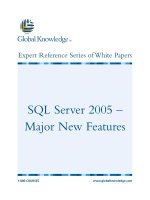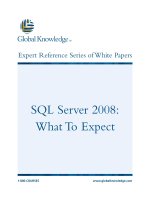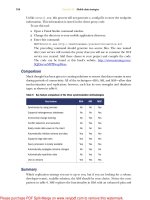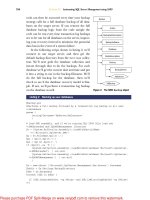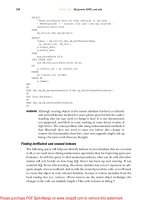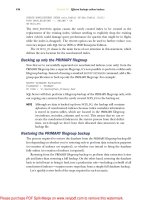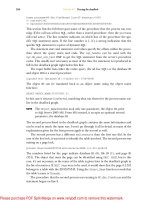Tài liệu SQL Server 2000 Fast Answers for DBAs and Developers pptx
Bạn đang xem bản rút gọn của tài liệu. Xem và tải ngay bản đầy đủ của tài liệu tại đây (10.41 MB, 1,013 trang )
SQL Server 2000
Fast Answers
for DBAs and Developers
Joseph Sack
SQL Server 2000 Fast Answers
for DBAs and Developers
(This book was originally published by Curlingstone in 2003.)
All rights reserved. No part of this work may be reproduced or transmitted in any form
or by any means, electronic or mechanical, including photocopying, recording, or by any
information storage or retrieval system, without the prior written permission of the copyright
owner and the publisher.
Printed and bound in the United States of America 9 8 7 6 5 4 3 2 1
Trademarked names may appear in this book. Rather than use a trademark symbol with every
occurrence of a trademarked name, we use the names only in an editorial fashion and to the
benefit of the trademark owner, with no intention of infringement of the trademark.
Distributed to the book trade in the United States by Springer-Verlag New York, Inc.,
233 Spring Street, 6th Floor, New York, NY 10013, and outside the United States by
Springer-Verlag GmbH & Co. KG, Tiergartenstr. 17, 69112 Heidelberg, Germany.
In the United States: phone 1-800-SPRINGER, fax 201-348-4505, e-mail
, or visit
.
Outside the United States: fax +49 6221 345229, e-mail
,
or visit
.
For information on translations, please contact Apress directly at 2560 Ninth Street,
Suite 219, Berkeley, CA 94710. Phone 510-549-5930, fax 510-549-5939, e-mail
, or visit
.
The information in this book is distributed on an “as is” basis, without warranty. Although
every precaution has been taken in the preparation of this work, neither the author(s) nor
Apress shall have any liability to any person or entity with respect to any loss or damage
caused or alleged to be caused directly or indirectly by the information contained in this
work.
The source code for this book is available to readers at
in the
Downloads section.
ISBN (pbk): 1-59059-592-0
Copyright © 2005 by Apress
Credits
Author Technical Reviewers
Joseph Sack Chris Barnwell
Glen Berry
Publisher
Greg Feirer
Fiona McParland Terry Hickman
Narayana Vyas Kondreddi
Commissioning Editor
Jeff Mason
Timothy Briggs Brian Moran
Paul Morris
Technical Editors
Craig Mullins
Duncan Black Massimo Nardone
Justin Crozier Alexzander Nepomnjashiy
Matthew Moodie Baya Pavliashvili
Indexer Production Manager
Bill Johncocks Zuned Kasu
Proofreader
Figures
Pauline Briggs Rachel Taylor
Pip Wonson
Cover Design
Dawn Chellingworth
Production Coordinators
Natalie O'Donnell Rachel Taylor
Corey Stewart Pip Wonson
About the Author
Joseph Sack is a database administrator and consultant based in
Minneapolis, Minnesota. Since 1997, he has been developing
and supporting SQL Server environments for clients in financial
services, IT consulting, and manufacturing. He is a Microsoft
Certified Database Administrator (MCDBA). Joe has a BA in
Psychology from the University of Minnesota, and so is
somewhat qualified to listen to what troubles you. You can visit
him at
.
Acknowledgments
Thank you to David Hatch, for your advice, encouragement, and patience in hearing me discuss the book
constantly.
Thank you to Barb Sorensen, who gave me my first break at becoming a DBA and developer. Barb sent me to
Seattle for SQL Server training six years ago, and gave me plenty of fun SQL Server projects to work on.
Thank you to Earl Fultz and Andrée Abecassis, for your initial advice and suggestions.
Lastly, I am very grateful to the great big team of editors here at Curlingstone. Your excellent suggestions
and careful review have really made this book what it is! Thank you to Tim Briggs, Duncan Black, Matthew
Moodie, Justin Crozier, Terry Hickman, Baya Pavliashvili, Narayana Vyas Kondreddi, Massimo Nardone,
Glenn Berry, Jeff Mason, Chris Barnwell, Craig S Mullins, Brian Moran, Greg Feirer, Paul Morris, and Sasha
Nepomnjashiy. Your feedback was critical and much appreciated.
Table of Contents
Preface xxi
Introduction xxiii
Chapter 1: Installation, Upgrades, Service Packs, and Database Migration 1
Common Installation Problems 2
Hardware and Operating System Requirements for SQL Server 2000 3
Pre-Installation Best Practices 5
1.1 How to… Install SQL Server 2000 11
1.2 How to… Install Analysis Services 13
1.3 How to… Install English Query 14
1.4 How to… Perform an Unattended Installation 15
1.5 How to… Perform a Remote Installation 17
1.6 How to… Install Only the Client Utilities 17
1.7 How to… Install Only Client Connectivity 18
1.8 How to… Uninstall SQL Server 18
1.9 How to… Troubleshoot a Failed Installation 19
SQL Server Instances: Overview and Best Practice 20
1.10 How to… Install a Named Instance of SQL Server 21
1.11 How to… Register Your Named Instance in SQL Server
Enterprise Manager 21
1.12 How to… Determine the Port Number for a Named Instance 22
Microsoft Data Access Components (MDAC) Defined 22
1.13 How to… Troubleshoot MDAC Installation 22
Ensuring Client Connectivity to Your Server 23
Table of Contents
ii
Upgrading to SQL Server 2000 from SQL Server 6.5 and 7.0 25
Database Compatibility Settings 25
Service Packs and Security Patches 26
1.14 How to… Find the Latest SQL Server Service Packs and Security Patches 27
1.15 How to… Install a Service Pack 27
1.16 How to… Uninstall a SQL Server Service Pack 29
1.17 How to… Install a Security Patch 32
1.18 How to… Roll Back a Security Patch 33
Post-Installation Best Practices 33
Database Migration Techniques 37
1.19 How to… Move Logins 37
1.20 How to… Fix Orphaned Logins 41
1.21 How to… Restore Another SQL Server's Database from Backup
to SQL Server 2000 42
1.22 How to…
……
… Use BCP 50
1.23 How to…
……
… Use BULK INSERT 54
Database Migration – Bringing It All Together 55
1.24 How to… Migrate Databases from SQL Server 6.5 to SQL Server 2000 55
1.25 How to… Migrate Data from Microsoft Access 60
1.26 How to… Migrate Data from Microsoft Excel 64
Chapter 2: Configuring SQL Server 67
2.1 How to… Configure Server Options with Enterprise Manager 67
2.2 How to… Configure and View Server Options with sp_configure 68
2.3 How to… Use RECONFIGURE WITH OVERRIDE 70
2.4 How to... Configure Server Options 70
2.5 How to… View Server Property Information with SERVERPROPERTY 103
2.6 How to… Show Version Information for Your Server – xp_msver 105
2.7 How to… View Server Default Collation using SELECT
SERVERPROPERTY 109
Table of Contents
iii
2.8 How to… View Server Default Collation using sp_helpsort 109
2.9 How to… Create a Database with a Collation Different from the
Server Default 110
2.10 How to… Change Database Collation 111
2.11 How to… Create a Table with a Column using a Non-Default Collation 111
2.12 How to… Change a Column's Collation 112
2.13 How to… Use the COLLATE Statement in a Transact-SQL Statement 113
2.14 How to… Use COLLATIONPROPERTY 113
2.15 How to… Change Default Server Collation with the Rebuild Master
Utility 114
Chapter 3: Creating and Configuring Databases 119
SQL Server Storage Internals 119
Estimating Growth 123
The System Databases 126
Creating, Configuring, and Modifying Your Database 126
3.1 How To… Create a Database in SQL Server 2000 126
3.2 How to… Add a Data or Log File to an Existing Database 134
3.3 How to… Remove a Data or Log File from a Database 135
3.4 How to… Change a File's Logical Name 137
3.5 How to… Change a Database Owner 137
Database Options 138
3.6 How to… View Database Options with DATABASEPROPERTYEX 153
3.7 How to… View User Options for the Current Connection with DBCC
USEROPTIONS 155
3.8 How to… Set User Options in Query Analyzer 156
3.9 How to… Rename a Database with sp_renamedb 160
3.10 How to… Show Database Information with sp_helpdb 160
3.11 How to… Show Log Size and % Space Used for Each Database 161
3.12 How to… Report and Correct Inaccuracies in the sysindexes Table
with DBCC UPDATEUSAGE 162
Table of Contents
iv
3.13 How to… View Space Usage with sp_spaceused 163
3.14 How to… Shrink Data and Log Files in a Database with DBCC
SHRINKDATABASE 164
3.15 How to… Shrink Data Files in a Database using Enterprise Manager 165
3.16 How to… Shrink a Specific Data Or Log File using DBCC SHRINKFILE 167
Filegroups 170
3.17 How to… Add a User-Defined Filegroup 171
3.18 How to… Make a User-Defined Filegroup the Default Filegroup 172
3.19 How to… Make a Filegroup Read-Only 174
3.20 How to… Place a Table into a Filegroup 174
3.21 How to… Change a Filegroup for an Existing Table 177
3.22 How to… Change a Filegroup for an Existing Index 178
3.23 How to… Remove a Filegroup 179
3.24 How to… Create Database Objects using Enterprise Manager 180
Chapter 4: SQL Server Agent and SQL Logs 197
4.1 How to… Configure SQL Server Agent Properties 198
4.2 How to… Use xp_cmdshell 202
4.3 How to… Set up the Proxy Account 203
4.4 How to… Add Alerts 206
Checklist… Recommended Alerts – What to Monitor 208
4.5 How to… Add Operators 210
4.6 How to… Add and Configure Jobs 211
4.7 How to… Create Job Categories 215
Configuring SQL Mail and SQLAgentMail 216
4.8 How to… Troubleshoot SQL Mail and SQLAgentMail 217
4.9 How to… Configure SQL Mail for a Valid POP3 Server 218
4.10 How to… Use Alternative E-Mail Solutions 218
4.11 How to… Use xp_sendmail 219
4.12 How to… Process Incoming E-Mails with SQL Mail Procedures 221
Table of Contents
v
4.13 How to… Configure Multi-Server Administration 222
4.14 How to… Configure the Master Server 223
4.15 How to… Set up Target Servers 223
4.16 How to… Create a Multi Server Job 223
4.17 How to… View Multi-Server Job History 225
4.18 How to… Defect a Target Server 225
4.19 How to… Script Jobs, Operators, and Alerts 226
4.20 How to… Transfer Jobs using DTS 227
4.21 How to… Delete or Re-Assign Jobs Belonging to a Specified Login
using sp_manage_jobs_by_login 228
4.22 How to… Purge Job History Rows with sp_purge_jobhistory 228
4.23 How to… Start and Stop a Job with Transact-SQL Stored
Procedures sp_start_job and sp_stop_job 229
4.24 How to… View and Interpret SQL Server Agent Error Logs 230
4.25 How to… Change the Name or Location of the SQL Server Agent
Error Log 231
SQL Server Agent Stored Procedures 231
SQL Server Error Log 234
4.26 How to… Read the SQL Server Error Log 234
4.27 How to… Setting the Number of SQL Server Error Logs to Keep 235
4.28 How to… Start up a New SQL Server Error Log without Restarting
the SQL Server Service 235
4.29 How to… Change the Logging Status of an Error Message with
sp_altermessage 236
4.30 How to… Log a User-Defined Message with xp_logevent 238
Chapter 5: Transactions, Locking, Blocking, and Deadlocking 241
Understanding Transactions 241
5.1 How to… Use a Transaction Mark 248
Best Practices for using Transactions 249
5.2 How to… Display the Oldest Active Transaction with DBCC OPENTRAN 249
Table of Contents
vi
5.3 How to… Use SET TRANSACTION ISOLATION LEVEL 251
5.4 How to… Use SET CURSOR_CLOSE_ON_COMMIT 252
5.5 How to… Use SET REMOTE_PROC_TRANSACTIONS 253
Lock Types, Compatibility, Isolation Levels, and Hints 254
5.6 How to… View Locking Activity in Enterprise Manager 262
5.7 How to… Use sp_who 263
5.8 How to… Use DBCC INPUTBUFFER and DBCC OUTPUTBUFFER 265
5.9 How to… Use fn_get_sql 266
5.10 How to… Use SET LOCK_TIMEOUT 266
Blocking and Deadlocking Defined 267
Why Blocking and Deadlocking Happen 268
5.11 How to… Identify and Resolve Blocking 268
5.12 How to… Identify Deadlocks with Trace Flag 1204 271
5.13 How to… Enable Trace Flags at SQL Server Startup 273
5.14 How to… SET DEADLOCK_PRIORITY 274
5.15 How to… Capture Deadlock Activity using SQL Profiler 275
Troubleshooting Blocking and Deadlocking Problems 281
Chapter 6: Backup, Recovery, and Maintenance 285
Creating a Backup and Recovery Plan 285
Checklist... When Problems Occur… 286
Checklist... If You Have to Rebuild Your Server... 286
Database Backup Methods 287
Understanding the Transaction Log 291
Checkpoints 292
6.1 How to… Perform Full, Differential, File, Filegroup, and Transaction
Log Backups with Enterprise Manager 293
6.2 How to… Create a Named Backup Device 296
6.3 How to… Perform a Full Database Backup with Transact-SQL 298
6.4 How to… Perform a Transaction Log Backup using Transact-SQL 301
Table of Contents
vii
6.5 How to... Perform a Differential Backup using Transact-SQL 303
6.6 How to... Backup Individual Files or Filegroups using Transact-SQL 303
Checklist... Backup Reminders 304
6.7 How to… Restore a Database using Enterprise Manager 305
6.8 How to… Use RESTORE FILELISTONLY 309
6.9 How to… Use RESTORE HEADERONLY 310
6.10 How to… Use RESTORE LABELONLY 312
6.11 How to… Restore a Database from a Full Backup using Transact-SQL 313
6.12 How to… Restore a Database from a Differential Backup using
Transact-SQL 316
6.13 How to… Restore a Database from a Transaction Log Backup using
Transact-SQL 317
6.14 How to… Restore a File or Filegroup 320
6.15 How to… Do a PARTIAL Restore to a New Database 320
6.16 How to… Recover from File Loss or Database Corruption 321
Corrupted Binary Files 323
6.17 How to… Reset a Suspect Database with sp_resetstatus 324
6.18 How to… Rebuild the Registry 326
6.19 How to… Start SQL Server in Single-User Mode 326
6.20 How to… Set Up a Database Maintenance Plan 326
6.21 How to… Investigate Maintenance Plan Failures 336
6.22 How to… Use the xp_sqlmaint or SQLMaint Utility 337
6.23 How to… Check Consistency of the Disk Space Allocation
Structures with DBCC CHECKALLOC 340
6.24 How to… Check System Table Consistency with DBCC
CHECKCATALOG 344
6.25 How to… Check Table Integrity with DBCC CHECKCONSTRAINTS 344
6.26 How to… Check Allocation and Structural Integrity of All Database
Objects with DBCC CHECKDB 347
6.27 How to… Check data, index, text, ntext, and image Pages for
Tables or Indexed Views Using DBCC CHECKTABLE 350
Table of Contents
viii
6.28 How to… Check Allocation and Structural Integrity of All Tables in
a Filegroup using DBCC CHECKFILEGROUP 352
6.29 How to… Disable Parallelism in DBCC CHECKDB, DBCC
CHECKFILEGROUP, and DBCC CHECKTABLE 354
6.30 How to… Output DBCC Data in Tabular Form using WITH
TABLERESULTS 355
Index Fragmentation 356
6.31 How to… Rebuild Indexes with DBCC DBREINDEX 356
6.32 How to… Defragment Indexes with DBCC INDEXDEFRAG 358
6.33 How to… Defragment Heaps 360
6.34 How to… Reclaim Space after Dropping Variable Length or Text
Columns with DBCC CLEANTABLE 361
Chapter 7: Security 363
SQL Server Logins, Users, Roles, and Permissions 364
7.1 How to... Create Logins using Enterprise Manager and Transact-SQL 369
7.2 How to... Remove a SQL Server Login using Enterprise Manager or
Transact-SQL 373
7.3 How to... Change the Default Database for a Login with
sp_defaultdb 373
7.4 How to... Change the Default Login Language using
sp_defaultlanguage 374
7.5 How to... List Defunct NT Users or Groups with Access to SQL Server 374
7.6 How to... Change or Add a Password in Enterprise Manager or
Transact-SQL 375
7.7 How to... Create Database Users in Enterprise Manager or
Transact-SQL 376
7.8 How to... Remove a User From the Database 377
7.9 How to... Create and Manage User-Defined Database Roles 379
7.10 How to... Display User-Defined or Fixed Database Roles in the
Current Database using sp_helprole 382
7.11 How to... Display Members of a Specific Database Role using
sp_helprolemember 383
Table of Contents
ix
7.12 How to... Create, Manage, and Drop Application Roles 384
7.13 How to... Show Users and Roles with Access to the Current
Database using sp_helpuser 386
7.14 How to... Display Account Permissions and Permission Path using
xp_logininfo 387
7.15 How to... Deny SQL Server Access to a Windows NT User or Group
using sp_denylogin 388
7.16 How to... Return a List of Fixed Server Roles with sp_helpsrvrole 388
7.17 How to... Display Permissions for Fixed Server Roles with
sp_srvrolepermission 389
7.18 How to... List Members of a Fixed Server Role using
sp_helpsrvrolemember 390
7.19 How to... Return a List of Fixed Database Roles with
sp_helpdbfixedrole 391
7.20 How to... Display Fixed Database Role Permissions 392
SQL Server Permission Types 392
7.21 How to... GRANT, REVOKE, or DENY Statement and Object Permissions 394
7.22 How to... Report User Permissions and Statement Permissions
using sp_helprotect 402
7.23 How to... Audit Security with SQL Profiler 406
7.24 How to... Audit Logins at the OS Level 411
7.25 How to... Monitor Updates with Triggers 412
Chapter 8: Replication 419
Replication Topology 420
Replication Types 421
Replication Configuration Methods 426
Data Type Considerations 426
SQL Server Version Compatibility 427
Pre-Replication Checklist 428
8.1 How to… Configure Snapshot Replication 429
8.2 How to… Create a Transactional Replication Publication 440
8.3 How to… Create a Merge Replication Publication 448
Table of Contents
x
8.4 How to… Push a Subscription 456
8.5 How to… Create a Pull Subscription 460
8.6 How to… Transform Data Within Your Publication 464
8.7 How to… Use Dynamic Filters and Dynamic Snapshots for a Merge
Publication 468
8.8 How to… Use Windows Synchronization Manager 476
8.9 How to… Configure Publication Properties 481
8.10 How to… Use Interactive Conflict Resolvers 491
8.11 How to… View Merge Replication Conflicts using Enterprise Manager 494
8.12 How to… Configure an Attachable Subscription Database 495
8.13 How to… Validate Replicated Data 497
8.14 How to… Launch Replication Wizards from Enterprise Manager 501
8.15 How to… Create and Manage Publications in Enterprise Manager 502
8.16 How to… Generate a Transact-SQL Script of Your Publication
and Subscribers 502
8.17 How to… Configure Topology Roles from Enterprise Manager 504
8.18 How to… Configure Agent Profiles 507
8.19 How to… Disable Publishing and Distribution on Your Server 512
Replication System Tables 513
8.20 How to… Find Help Troubleshooting Replication Problems 517
Chapter 9: Linked Servers 521
Checklist: Functionality and Performance Considerations for Linked Servers 521
9.1 How to... Add a Linked Server 522
9.2 How to... Execute Distributed Queries with a Linked Server 534
9.3 How to... Execute Ad Hoc Distributed Queries using OPENROWSET
and OPENDATASOURCE 536
9.4 How to... List All Tables from a Linked Server using sp_tables_ex 538
9.5 How to... Show Privilege Information about a Linked Server Table
with sp_table_privileges_ex 539
9.6 How to... Display Column Data for a Linked Server Table using
sp_columns_ex 540
Table of Contents
xi
9.7 How to… Return Column Privileges for a Linked Server Table using
sp_column_privileges_ex 541
9.8 How to... List Linked Servers Defined on Your Local Server 542
9.9 How to… Troubleshoot Linked Servers and Distributed Queries 543
Chapter 10: Failover Clustering 549
Cluster Meta Data 553
Cluster Administrator 553
Pre-Installation Checklist for SQL Server Failover Clustering 554
10.1 How to… Install a SQL Server 2000 Virtual Server 555
10.2 How to… Install a Service Pack for a SQL Server 2000 Virtual Server 557
10.3 How to… Implement Post-Installation Steps 558
Adding Additional Disk Resources 559
Other Post-Installation Configurations to Monitor 559
10.4 How to… Troubleshoot a Failed SQL Server Virtual Server 560
10.5 How to… Uninstall a SQL Server 2000 Virtual Server 560
Chapter 11: DTS 563
11.1 How to... Use DTS Designer 564
11.2 How to... Add and Configure a Connection Object 565
11.3 How to... Add a New Task 568
11.4 How to... Configure the File Transfer Protocol Task 568
11.5 How to... Configure the ActiveX Script Task 570
11.6 How to... Configure the Transform Data Task 572
Configuring the Execute Process Task 587
11.7 How to... Configure the Execute SQL Task 588
11.8 How to... Configure the Data Driven Query Task 589
11.9 How to... Configure the Copy SQL Server Objects Task 594
11.10 How to... Configure the Send Mail Task 595
11.11 How to... Configure the Bulk Insert Task 596
Table of Contents
xii
11.12 How to... Configure the Execute Package Task 597
11.13 How to... Configure the Message Queue Task 598
11.14 How to... Configure Transfer Tasks 602
11.15 How to... Configure the Dynamic Properties Task 604
Configuring Workflow 606
Understanding the DTS Package Execution Context 609
11.16 How to… Configure Package Properties 611
11.17 How to… Set the Package Owner and User Password 613
11.18 How to… Schedule a DTS Package 614
11.19 How to… Use dtsrun 616
11.20 How to… Generate a dtsrun String Dynamically via dtsrunui 619
11.21 How to… Register a Custom Task 620
11.22 How to… Transfer DTS Packages between Servers 621
11.23 How to… Troubleshoot DTS Packages 622
Chapter 12: Log Shipping 625
The Log Shipping Process 625
Checklist… Log Shipping Pre-Configuration Recommendations and
Best Practices 627
12.1 How to… Set up Log Shipping with the Database Maintenance
Plan Wizard 628
12.2 How to… Monitor Log Shipping Status 634
12.3 How to… Configure Log Shipping Properties 636
12.4 How to… Create a Primary Role Change for the Secondary Server 637
12.5 How to… Troubleshoot Log Shipping 640
Chapter 13: Other Utilities 645
13.1 How to… Use osql 645
13.2 How to… Use Query Analyzer Templates 651
13.3 How to… Use the Query Analyzer Object Browser 654
13.4 How to… Use the Query Analyzer Keyboard Shortcuts 657
Table of Contents
xiii
13.5 How to… Use SQLDIAG 659
13.6 How to… Check the Port Number of a Named Instance using the
Server Network Utility 661
13.7 How to… Create a Client-Side Alias using the Client Network Utility 662
13.8 How to… Configure Full-Text Indexing 663
13.9 How to… Use Full-Text Index Stored Procedures 668
13.10 How to… Query a Full-Text Index 672
13.11 How to… Create Custom Messages 677
Chapter 14: DDL 681
14.1 How to… Create a Table 681
14.2 How to… Create a Table with a Primary Key 684
14.3 How to… Create a Unique Constraint 686
14.4 How to… Create a Computed Column 686
14.5 How to… Place a Table on a Filegroup 688
14.6 How to… Place Text or Images on a Separate Filegroup 688
14.7 How to… Create a Table with a Foreign Key Reference 689
14.8 How to... Set Recursive Foreign Key References 690
14.9 How to... Create a Cascading Change with ON DELETE 691
14.10 How to... Create a Cascading Change with ON UPDATE 691
14.11 How to… Use CHECK Constraints 692
14.12 How to… Use the DEFAULT Property During Table Creation 693
14.13 How to… Use the IDENTITY Property During Table Creation 694
14.14 How to… Use DBCC CHECKIDENT to View and Correct IDENTITY
Seed Values 697
14.15 How to… Use ROWGUIDCOL 698
14.16 How to… Specify Column Collation 699
14.17 How to… Add a Column to an Existing Table 699
14.18 How to… Drop a Column and Constraints from a Table 700
14.19 How to… Change a Column Definition 700
Table of Contents
xiv
14.20 How to… Remove the ROWGUIDCOL Property 701
14.21 How to… Add a Primary Key Constraint to an Existing Table 702
14.22 How to… Add a Foreign Key Constraint to an Existing Table 702
14.23 How to… Add a DEFAULT Constraint to an Existing Table 703
14.24 How to… Add a CHECK Constraint to an Existing Table 703
14.25 How to… Add a UNIQUE Constraint to an Existing Table 704
14.26 How to… Disable and Enable Constraints 704
14.27 How to… Drop a Table 704
14.28 How to… Create a Temporary Table 705
14.29 How to… Create a Table Variable 706
14.30 How to… Set Table Options with sp_tableoption 706
14.31 How to… Display Constraint Information for a Table Using
sp_helpconstraint 707
14.32 How to… Use DBCC PINTABLE to Place a Table's Data Pages
Into Memory 708
Performance Impact of Constraints 709
Views, Updateable Views, Indexed Views, Partitioned Views 709
14.33 How to… Create a View 712
14.34 How to… Create an Indexed View 713
14.35 How to… Create a Partitioned View 715
14.36 How to… Change a View 717
14.37 How to… Drop a View 718
14.38 How to… Refresh Meta Data for a Specific View 718
Stored Procedures 718
14.39 How to… Create Stored Procedures 719
14.40 How to… Modify Stored Procedures 721
14.41 How to… Drop Stored Procedures 722
14.42 How to… Run Stored Procedures at Startup 722
14.43 How to… Force a Stored Procedure to Recompile 722
14.44 How to… Print the Text of the Stored Procedure 723
Table of Contents
xv
14.45 How to… Force a Flush of the Procedure Cache 723
14.46 How to… Add an Extended Stored Procedure 724
14.47 How to… Show the Name of the DLL Associated with an Extended
Stored Procedure 724
14.48 How to… Unload the Extended Stored Procedure DLL from Memory 725
14.49 How to… Remove an Extended Stored Procedure 725
User-Defined Functions 725
14.50 How to… Create Scalar User-Defined Functions 727
14.51 How to… Create Inline User-Defined Functions 728
14.52 How to… Create Multistatement User-Defined Functions 729
14.53 How to… Modify User-Defined Functions 731
14.54 How to… Drop User-Defined Functions 731
Indexes 731
14.55 How to… Create an Index 733
14.56 How to… Drop an Index 735
14.57 How to… Display Indexes Defined for a Table 736
Triggers 736
14.58 How to… Create a Trigger 737
14.59 How to… Alter a Trigger 740
14.60 How to… Drop a Trigger 740
14.61 How to… Monitor the Nesting Level within a Trigger 740
14.62 How to… Specify the Firing Order of AFTER Triggers 741
14.63 How to… List Triggers for Table 741
14.64 How to… Enable and Disable Table Triggers 742
Working with Database Objects 743
14.65 How to… Change the Name of a User-Created Database Object 743
14.66 How to… Display Information About a Database Object 744
14.67 How to… Display Information on Database Object Dependencies 745
14.68 How to… Change an Object Owner 746
14.69 How to… Query the Meta Data of Database Objects 746
Table of Contents
xvi
Chapter 15: DML 749
15.1 How to… Use a Simple SELECT Statement 749
15.2 How to… Use DISTINCT to Remove Duplicate Values 751
15.3 How to… Use Column Aliases 753
15.4 How to… Use the TOP Keyword 754
15.5 How to… Use the WITH TIES Clause to Return Repeating Values in
the TOP Clause 754
15.6 How to… Create a Table using INTO 755
15.7 How to… Use the FROM Clause 757
15.8 How to… Use Table JOINs 757
15.9 How to… Use Table Aliases and Self Joins 763
15.10 How to… Use Derived Tables 764
15.11 How to… Use the WHERE Clause to Specify Rows Returned in the
Result Set 765
15.12 How to… Use the GROUP BY Clause 772
15.13 How to… Use the HAVING Clause 775
15.14 How to… Use the ORDER BY Clause 776
15.15 How to… Use Subqueries 778
15.16 How to… Use UNION to Combine Result Sets 780
15.17 How to… Use COMPUTE in a SELECT Statement 782
15.18 How to… Use the FOR Clause 783
15.19 How to… Use the INSERT Statement 784
15.20 How to… Use the UPDATE Statement 786
15.21 How to… Use the DELETE Statement 788
15.22 How to… TRUNCATE a TABLE 788
15.23 How to… Use Hints 789
Table of Contents
xvii
Chapter 16: Transact-SQL Techniques 793
16.1 How to… Use Aggregate Functions 793
16.2 How to… Use String Functions 800
16.3 How to… Use Date Functions 811
16.4 How to… Use Display Information with @@ Functions 814
16.5 How to… Use Mathematical Functions 818
16.6 How to… Use Security functions 825
16.7 How to… Use Meta Data Functions 827
16.8 How to… Use System Functions 830
16.9 How to… Use IMAGE, TEXT, and NTEXT Functions 836
16.10 How to… Use Information Schema Views 840
Normalization in a Nutshell 841
16.11 How to… Use CASE 844
BEGIN and END 845
16.12 How to… Use IF…ELSE 846
16.13 How to… Use WHILE, BREAK, and CONTINUE 847
16.14 How to… Use RETURN 849
16.15 How to... Use RAISERROR 850
Transact-SQL Cursors 852
16.16 How to… Create and use Transact- SQL Cursors 852
16.17 How to… Create Extended Properties 857
16.18 How to… Create a Script that Creates a Script 861
16.19 How to… Use sp_executesql 861
16.20 How to… Use String Concatenation 862
Batches 863
16.21 How to… Use EXEC 863
16.22 How to… Bind a Connection to Other Transactions using
sp_bindsession and sp_getbindtoken 864
16.23 How to… Use COM Automation sp_oa Procedures 865
16.24 How to… Remove All Clean Buffers from the Buffer Pool 870
16.25 How to… Use WAITFOR 870
Table of Contents
xviii
Chapter 17: Performance Tuning 873
17.1 How to… Use System Monitor to Identify Hardware Bottlenecks 873
Query Tuning Best Practices 886
17.2 How To… Use SQL Profiler to Capture Activity 887
17.3 How to… Script a Server-Side Profiler Trace 894
17.4 How to… Use SHOWPLAN_ALL, SHOWPLAN_TEXT 904
17.5 How to… Use Graphical Showplan 906
17.6 How to… Use SET STATISTICS IO 912
17.7 How to… Use SET STATISTICS TIME 912
17.8 How to… Use SET STATISTICS PROFILE 913
17.9 How to… Use Query Analyzer's Server Trace and Client Statistics 915
Checklist: Index Best Practices 916
17.10 How to… Display fragmentation using DBCC SHOWCONTIG 920
17.11 How to… Use the Index Tuning Wizard 922
17.12 How to… Use CREATE STATISTICS 925
17.13 How to… Display Columns with Statistics with sp_helpstats 926
17.14 How to… Show Current Distribution Statistics for a Table DBCC
SHOW_STATISTICS 927
17.15 How to… Update Statistics against all User-Defined Tables using
sp_updatestats 928
Chapter 18: XML 931
XML 931
The Anatomy of an XML Document 932
18.1 How to… Use FOR XML 935
18.2 How to… Use sp_makewebtask to Output XML Documents 939
18.3 How to… Use OPENXML 940
Index 945

